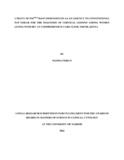| dc.contributor.author | Ngoma, Febian | |
| dc.date.accessioned | 2016-11-23T07:12:19Z | |
| dc.date.available | 2016-11-23T07:12:19Z | |
| dc.date.issued | 2016 | |
| dc.identifier.uri | http://hdl.handle.net/11295/97745 | |
| dc.description.abstract | Background: The current cervical cancer screening methods pose limitations. Since use of biomarkers has shown efficiency, there is need for a disease specific biomarker such as the p16INK4a /ki-67 Immunocytochemical (ICC) stain. Thus, the study focus was on evaluating the diagnostic utility of p16INK4a /Ki-67 ICC stain as an adjunct to conventional smear in cervical diagnosis.
Objective: The aim of the study was to determine the diagnostic utility of p16INK4a/ki-67 ICC stain as an adjunct to conventional Pap smear in the diagnosis of cervical lesions among women living with HIV at the Comprehensive Care Clinic (CCC) in KNH, Kenya.
Methodology: This was a descriptive cross sectional study which was undertaken at CCC at KNH for the duration of three months. A total of 61 women living with HIV who met the inclusion criteria were screened for cervical lesions. Only 35 (57.4% - response rate) of them were included in the comparative analysis. Twenty six (26) of the study participants were not included in the final analysis since most material was lost during cell block preparation. Ethical clearance was obtained from KNH/UON ethics and research committee. Consecutive cervical cytobrush liquid based cervical samples were stained for Pap method and a cell block was prepared from the residues for p16INK4a/Ki-67 ICC stain. Analysis was done using SPSS software for Windows v.22, at a significance level of P ≤ 0.05.
Results: The mean age of the 35 participant‟s was 41.1 years (SD ± 10.9). The cytomorphology results by Pap smear were 26 (74.3%) were NILM, 4(11.4%) HSIL, 2(5.7%) LSIL, 1 (2.9%) each of the ASCUS, ASC-H and SCC (P = 0.001). The p16INK4a and Ki-67 combination were 9/35 (25.7%) women tested positive (P = 0.004). Using Cohen's kappa statistics, there was moderate and significant agreement of the combined p16INK4a and Ki-67 with cytology (Kappa = 0.481; P = 0.001) and By Spearman test (r = 0.95 and P = 0.001).
Conclusions: The combined p16INK4a/Ki-67 ICC staining on cell block showed moderate agreement and strongly correlated with cytological results, indicating the usefulness of the biomarker for diagnosis of cervical cancer, especially in cases of ASCUS and ASC-H while improving the diagnostic accuracy of LSIL and HSIL.
Recommendation: The use of p16INK4a/ Ki-67 ICC can be used as a means of analyzing cervical cancer when used in conjunction with conventional cytology, therefore p16INK4a/Ki-67 biomarkers should be incorporated into the cervical cancer screening algorithms. However, a larger sample size should be conducted to validate these findings. | en_US |
| dc.language.iso | en | en_US |
| dc.publisher | University Of Nairobi | en_US |
| dc.rights | Attribution-NonCommercial-NoDerivs 3.0 United States | * |
| dc.rights.uri | http://creativecommons.org/licenses/by-nc-nd/3.0/us/ | * |
| dc.subject | The Diagnosis Of Cervical Lesions Among Women Living With HIV | en_US |
| dc.title | Utility Of P16Ink4A/ki-67 Immunostain As An Adjunct To Conventional Pap Smear For The Diagnosis Of Cervical Lesions Among Women Living With HIV At Comprehensive Care Clinic INKNH, Kenya | en_US |
| dc.type | Thesis | en_US |
| dc.description.department | a
Department of Psychiatry, University of Nairobi, ; bDepartment of Mental Health, School of Medicine,
Moi University, Eldoret, Kenya | |



